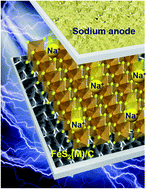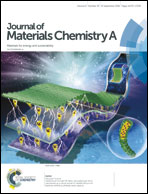Marcasite iron sulfide as a high-capacity electrode material for sodium storage†
Abstract
Iron sulfides have attracted significant attention as promising electrode materials for sodium-ion batteries (SIBs) owing to their low electronegativity, high theoretical capacity, and cost-effectiveness. However, the large size of sodium ions generally induces severe volume changes and sluggish sodium kinetics in iron sulfide electrodes, which have prevented their practical application in SIBs. Herein, an orthorhombic marcasite FeS2 was successfully synthesized under solvothermal conditions and subsequently modified using electro-conductive carbon. This report is the first to use marcasite FeS2 as an electrode material in Na cells. The FeS2/carbon composite exhibited a high Na-storage capacity with stable capacity retention in Na cells; specifically, a discharge capacity of 385 mA h g−1 (over 85% of the initial capacity) was retained after 200 cycles at 100 mA g−1. The following related Na-storage mechanism was proposed: FeS2 + 2Na+ + 2e− → FeS + Na2S on sodiation (reduction), and this reaction occurs reversibly on desodiation (oxidation). The FeS2 cathode in the Na cells delivered a high energy density of approximately 620 W h kg−1 even after 200 cycles, which is comparable to that of commercial cathode materials for lithium-ion batteries.



 Please wait while we load your content...
Please wait while we load your content...